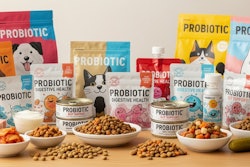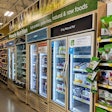
The level of pet owners giving probiotics to their pets now rivals usage by people for themselves, at least in the U.S. In a 2021 study of 16,000 consumers in 16 countries, 48% reported taking probiotics daily or nearly daily. No doubt the number is higher today; it’s not clear if the company behind the survey, Chr. Hansen (now Novonesis), has repeated it more recently.
However, its pet, animal and plant biosolutions division has conducted recent research on consumer understanding and purchasing behaviors for pet probiotics, including qualitative and quantitative studies of U.S. dog and cat owners (more than 500 of each) in March 2024. Those showed 47% of U.S. cat owners and 53% of dog owners are giving their pets probiotics, up from just 22% and 32%, respectively, in 2021.
That the usage rates increased so dramatically in just three years — and are so close to human usage rates — provides further confirmation of the importance of functional ingredients and claims to pet owners, the growing focus on gut health and how that, like many other concepts, has spilled over from human food and health.
Pet probiotic interest driven by health and wellness, gut health focus
The pet-related data was presented by Lidiia Alaverdova, DVM, head of global marketing and pet, animal and plant biosolutions for Novonesis, during Petfood Forum Europe 2024 in May. For comparison to the U.S. usage rates, she included data from the company’s previous research conducted in December 2020, including in France. That found only 16% of French pet owners gave their pets probiotics at the time. That is likely higher now, too, though my guess is it wouldn’t be as high as in the U.S.
The 2024 U.S. research shows 58% of pet owners are familiar with probiotics, and many associate these ingredients with general pet health and wellness. In fact, among a host of functional ingredients, probiotics ranked high for their relation to health and wellness, second (behind only vitamins) for dog owners and fourth (behind vitamins, omega-3s and minerals) for cat owners.
And, speaking of general health and wellness, that showed up as an important driver for these U.S. pet owners to purchase probiotics for their pets, named by 42%. Yet a functional benefit — digestive/gut health — was named by more, at 51%, second behind a veterinarian recommendation at 60%. (Respondents were prompted to select all options that applied.)
Digestive health is increasing in importance for pet owners around the world. According to Mintel’s global new product database, nearly 25% of all new pet food products launched in 2023 had digestive health claims, with such claims being most common in Asia.
Most U.S. pet owners provide probiotics via pet food
Interestingly, given the growing popularity of pet supplements, they fall fairly far behind other delivery methods for administering probiotics to pets, at least in the U.S. Pet food inclusion leads among U.S. pet owners for how they feed probiotics, named by 75% in the Novonesis research, followed at a much lower level by pet treats, then supplements. An even higher percentage, 84%, said they actively look for pet foods with probiotics indicated on the label, and 31% even said they’ll switch brands of pet foods to ensure the presence of probiotics.
In France, according to the 2020 research, the situation with preferred delivery methods is the opposite: 83% of owners reported giving probiotics as oral pet supplements, though supplements as toppers or in pet food or pet treats were named by almost as many owners. (They could choose all methods that applied.)
Delivery method aside, are pet owners willing to pay more for pet foods and other products with probiotics? The Novonesis 2024 research showed 87% of U.S. pet owners currently not feeding probiotics, but indicating a high likelihood to use them in the future, said they’re willing to pay a 1% to 5% premium for pet probiotics.
Yet, with many benefits and characteristics that consumers say they seek for their pets’ food — sustainability, less processing, high protein and the like — what they say doesn’t always match their actual behavior. That’s especially true when it comes to paying a premium, a big ask on top of higher pet food prices in these inflationary times.



















